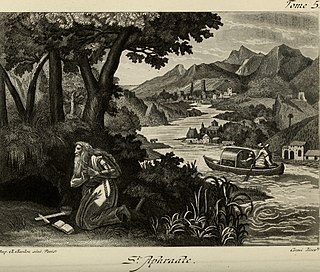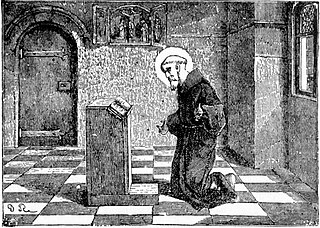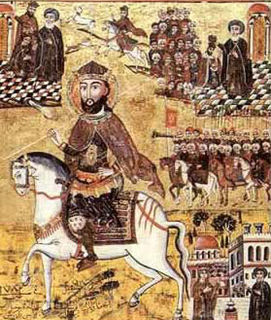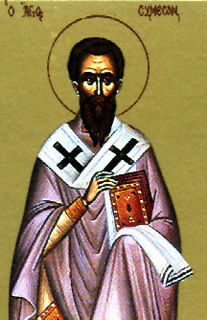 W
WAba I or Mar Abba the Great was the Patriarch of the Church of the East at Seleucia-Ctesiphon from 540 to 552. He introduced to the church the anaphoras of Theodore of Mopsuestia and Nestorius beside the more ancient liturgical rite of Addai and Mari. Though his tenure as catholicos saw Christians in the region threatened during the Persian-Roman wars and attempts by both Sassanid Persian and Byzantine rulers to interfere with the governance of the church, his reign is reckoned a period of consolidation, and a synod he held in 544 as instrumental in unifying and strengthening the church. He is thought to have written and translated a number of religious works. After his death in February 552, the faithful carried his casket from his simple home across the Tigris to the monastery of Mar Pithyon.
 W
WAbdas, was bishop of Susa in Iran. Socrates of Constantinople calls him "bishop of Persia". He was executed under the orders of shah Yazdegerd I after to refusing to rebuild a Zoroastrian fire temple that he had destroyed.
 W
WSaints Abdon and Sennen, variously written in early calendars and martyrologies Abdo, Abdus, and Sennes, Sennis, Zennen, are recognized by the Roman Catholic Church as Christian Martyrs, with a feast day on 30 July. In some places they have been honoured on 20 March, and the first Sunday of May.
 W
WSaint Anastasius of Persia, was originally a Zoroastrian soldier in the Sasanian army. He later became a convert to Christianity and was martyred in 628.
 W
WAphrahat was a Syriac Christian author of the third century from the Persian / Sasanian Empire who composed a series of twenty-three expositions or homilies on points of Christian doctrine and practice. All his known works, the Demonstrations, come from later on in his life. He was an ascetic and celibate, and was almost definitely a son of the covenant. He may have been a bishop, and later Syriac tradition places him at the head of Mar Mattai Monastery near Mosul in what is now Iraqi Kurdistan. He was a near contemporary to the slightly younger Ephrem the Syrian, but the latter lived within the sphere of the Roman Empire. Called the Persian Sage, Aphrahat witnesses to the concerns of the early church beyond the eastern boundaries of the Roman Empire.
 W
WBademus was a rich, noble citizen of Bethlapeta in Persia, who founded a monastery nearby. He and some of his disciples were arrested and Bademus was martyred in the year 376; he was subsequently recognized as a saint.
 W
WSaints Behnam, Sarah, and the Forty Martyrs were 4th-century Christians who suffered martyrdom during the reign of Shapur II. They are venerated as saints in the Oriental Orthodox Church.
 W
WBenjamin was a deacon martyred circa 424 in Persia. Benjamin was executed during a period of persecution of Christians that lasted forty years and through the reign of two Persian kings: Isdegerd I, who died in 421, and his son and successor, Varanes V. King Varanes carried on the persecution with such great fury that Christians were submitted to the most cruel tortures.
 W
WEustathius or Eustace of Mtskheta is an Orthodox Christian saint, executed for his apostasy from Zoroastrianism by the Sasanian military authorities in Caucasian Iberia. His story is related in the anonymous 6th-century Georgian hagiographic novel The Passion of Eustathius of Mtskheta.
 W
WSaint Gabriel of Beth Qustan, also known as Saint Gabriel of Qartmin, was the Bishop of Tur Abdin until his death in 648. He is venerated as a saint in the Oriental Orthodox Church and his feast day is 23 December.
 W
WIsaac or Sahak of Armenia (354–439) was Catholicos of the Armenian Apostolic Church. He is sometimes known as "Isaac the Great," and as "Sahak the Parthian" owing to his Parthian origin.
 W
WSaint James Intercisus, also known as Saint James the Mutilated was a Syriac Christian saint born in Beth Huzaye in Persia. His epithet, Intercisus, is derived from the Latin word for "cut into pieces," which refers to the manner of his martyrdom: he was slowly cut into twenty-eight pieces. His death started the Roman-Sassanid War (421-422).
 W
WJavanshir, was the prince of Caucasian Albania from 637 to 680, hailing from the region of Gardman. His life and deeds were the subject of legends that were recorded in Armenian medieval texts. He was from the Parthian Mihranid family, an offshoot of the House of Mihran, one of the seven Parthian clans of the Sasanian Empire.
 W
WVahan Mamikonian was an Armenian nobleman from the Mamikonian family. In 481 he rebelled against the Sasanian Empire that controlled the eastern part of Armenia known as Persian Armenia. He was appointed as marzban (governor) of Persian Armenia in 485 and remained in that post until his death around 503-510.
 W
WSaint Maruthas or Marutha of Martyropolis was a Syrian monk who became bishop of Maypherkat in Mesopotamia (Meiafarakin) for a period beginning before 399 through 410. He's believed to have died before 420. He is venerated as a Saint by Catholics, Greek Orthodox believers and Copts, his feast being kept on 4 December.
 W
WMesrop Mashtots listen (help·info) was an early medieval Armenian linguist, composer, theologian, statesman and hymnologist. He is best known for inventing the Armenian alphabet c. 405 AD, which was a fundamental step in strengthening Armenian national identity. He is also considered to be the creator of the Caucasian Albanian and Georgian alphabets by some scholars.
 W
WMiles, sometimes Mar Miles, was the bishop of Susa in Sasanian Persia from before 315 until his martyrdom in 340 or 341. He engaged in efforts to evangelize Susa, traveled widely in the Eastern Roman Empire and led the opposition to Papa bar ʿAggai and the supremacy of the bishops of Seleucia-Ctesiphon in the Persian church. He was executed by the Sasanian authorities at the start of the Forty-Year Persecution.
 W
WMirian III was a king of Iberia or Kartli (Georgia), contemporaneous to the Roman emperor Constantine the Great. He was the founder of the royal Chosroid dynasty.
 W
WMovses Khorenatsi was a prominent Armenian historian from the period of Late Antiquity and the author of the History of Armenia.
 W
WRabban Mar Hormizd was a monk who lived in the seventh century in modern northern Iraq. Rabban is the Syriac term for monk. "Rabban" is also the Aramaic word for "teacher". He founded the Rabban Hormizd Monastery in Alqosh, named after him, which has served in the past as the patriarchate of the Church of the East.
 W
WRazhden was a 5th-century Persian nobleman in the service of the Georgian king Vakhtang I of Iberia and a convert to Christianity who was executed by the Sassanid military in Iberia. He was canonized by the Georgian Orthodox Church as St. Razhden the Protomartyr, with his feast day marked on August 16.
 W
WShirin was a wife of the Sassanid Persian Shahanshah, Khosrow Parviz. In the revolution after the death of Khosrow's father Hormizd IV, the General Bahram Chobin took power over the Persian empire. Shirin fled with Khosrow to Syria, where they lived under the protection of Byzantine emperor Maurice. In 591, Khosrow returned to Persia to take control of the empire and Shirin was made queen. She used her new influence to support the Christian minority in Iran, but the political situation demanded that she do so discreetly. Initially she belonged to the Church of the East, the so-called Nestorians, but later she joined the miaphysite church of Antioch, now known as the Syriac Orthodox Church. After conquering Jerusalem in 614, amidst the Byzantine–Sasanian War of 602–628, the Persians captured the True Cross of Jesus and brought it to their capital Ctesiphon, where Shirin took the cross in her palace.
 W
WShushanik, born Vardeni Mamikonian was a Christian Armenian woman who was tortured to death by her husband Varsken in the town of Tsurtavi, Georgia. Since she died defending her right to profess Christianity, she is regarded as a martyr. Her martyrdom is described in her confessor Jacob’s hagiographic work, the oldest extant work of Georgian language literature. The hagiography details extensive resistance to forms of imprisonment, isolation, torture and cruelty by Shushanik.
 W
WMar Shimun Bar Sabbae was an Bishop of Seleucia-Ctesiphon, from Persia, the de facto head of the Church of the East, until his death. He was bishop during the persecutions of King Shapur II of the Sasanian Empire of Iran, and was executed along with many of his followers. He is revered as a saint in various Christian communions.
 W
WVakhtang I Gorgasali, of the Chosroid dynasty, was a king of Iberia, natively known as Kartli in the second half of the 5th and first quarter of the 6th century.